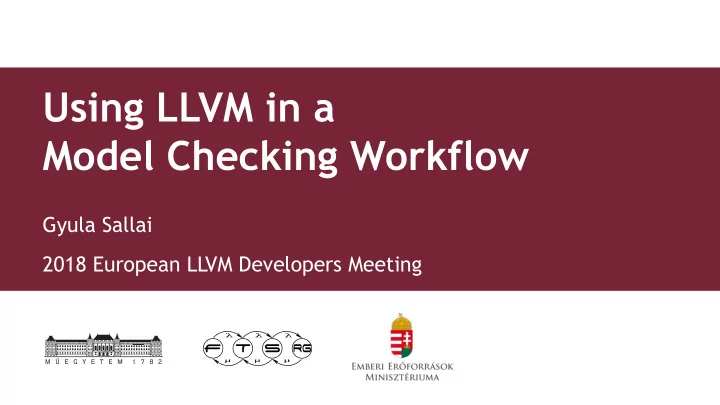

Using LLVM in a Model Checking Workflow Gyula Sallai 2018 European LLVM Developers Meeting
Introduction
Motivation Embedded software systems o Usually written in C ¬ (Red ∧ Green) Confidence in correctness? Formal Formal model property Model checking OK Counterexample 3
Software model checking Automatic transformation from source code C code erroneous state Program model not reachable Model checking OK Counterexample Model checking is computationally hard o Undecidable in general o Model size/complexity must be reduced 4
LLVM for model checking LLVM IR as a language frontend? o Language-agnostic o Optimization infrastructure Using LLVM IR for model checking theta framework 1 C Formal LLVM IR C++ model … optimizations Verification backend 1 https://github.com/ftsrg/theta 5
Transformation to formal models
Formal model for computer programs Control flow automata (CFA) int i = 0; int sum = 0; while (i < 11) { sum = sum + i; i = i + 1; } assert(i == 11); error: failing assertions 7
LLVM IR to formal models Gap between the IR and formal models o Designed for compilation designed for theorem provers LLVM IR has more expressive power o SSA, ϕ -nodes transformation rules o Pointers theory of arrays, integer addresses o Global variables promotion to locals o Procedure calls function inlining 8
9 LLVM IR to formal models CFG CFA bb0: 1 x 0 = call read() havoc x 0 br (incr, bb1, bb2) 2 assume not incr assume incr bb1: bb2: 3 5 x 2 = x 0 - 1 x 1 = x 0 + 1 x 1 := x 0 + 1 x 2 := x 0 - 1 4 6 bb3: x 4 := x 1 x 4 := x 2 x 4 = ϕ ({x 1 , bb1}, {x 2 , bb2}) 7 ... 9
Optimization algorithms
Optimizations Need to be configurable Optimizations in LLVM o Constant propagation, dead code elimination o Function inlining Other transformations o Global variables to locals o Program slicing 11
Program slicing Slice: subprogram, which produces the same output and assigns the same values to a set of variables as the original program. 0: int i = 0; 0: int i = 0; 1: int x = 0; 1: int x = 0; 2: while (i < 11) { 2: while (i < 11) { 3: x = x + i; 3: x = x + i; 4: i = i + 1; 4: i = i + 1; } } 5: assert(i != 0); 5: assert(i != 0); Criterion: value of i at statement 5 12
Evaluation
Evaluation SV-Comp: Competition on Software Verification 1 o Verification tasks written in C Program categories o locks : locking mechanisms o eca: event-driven systems o ssh: ssh protocol 1 https://sv-comp.sosy-lab.org/2016/ 14
Evaluation *Opt: with optimizations *Slice: with slicing Model Vars Locs VarsOpt LocsOpt #Slice VarSlice LocsSlice Many small slices 10 locks10 55 236 52 231 5.5 27 14 locks14 75 324 72 319 5.5 26.5 Some reduction with optimizations, more with 1 eca1 1104 2937 976 2870 614 1908 slicing 1 eca2 1040 2854 892 2778 590 1936 1 eca3 3269 10719 2781 10325 2408 9050 Significant reduction 1 ssh1 196 693 174 648 109 394 16
Summary Software model checking C code error is not CFA reachable Model checking LLVM IR-based model checking OK Counterexample o Transformation to formal models o Configurable optimizations o Program slicing Future work o Improved pointer support o New slicing methods (heuristics...) 17
Recommend
More recommend